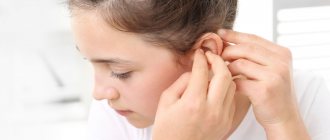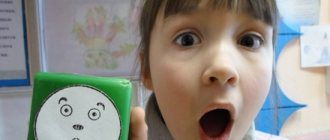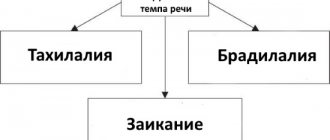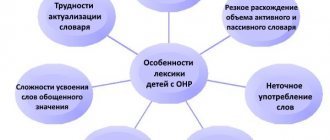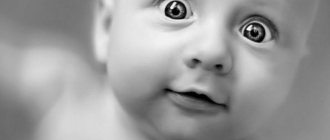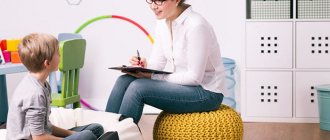An example of speech cards for students with severe speech impairments
3.1.
The structure of the articulatory apparatus
without any features
3.2.
Motor functions of the articulation apparatus,
erased form of dysarthria
3.3.
Speech breathing and voice formation
There are no disturbances in the rhythm of speech breathing and voice formation
4. Prosodic design of speech Speech rate is slow; makes accent errors; speech is intonationally inexpressive; makes errors in intonation division/integration of speech; the understanding of logical stress is impaired, the ability to reproduce intonation structures of various types is impaired; no speech rhythm disturbances
5. Motor development
5.1. Development of basic motor skills and coordination area motor clumsiness, clumsiness, fine manual motor skills defects
5.2. Formation of purposeful movements (praxis), poor coordination of movements, hypertonicity of the hands
6. Psychological basis of speech
6.1. Verbal memory: memory volume does not correspond to age norm: difficulties in reproducing information presented in verbal form
6.2. Speech attention is not formed, significant difficulties in concentrating/distributing attention when working with verbal material
6.3. Thinking (verbal and non-verbal intelligence) does not correspond to the age norm: significant difficulties in establishing logical connections between linguistic units; difficulties in understanding/producing logical-grammatical structures
7. Additional information
7.1.Features of early speech development : humming - 2.5 months, babbling - 5.5, first words by 1 year, first phrases - 2.5 years, phrasal speech - 3 years 3 months (according to mother)
7.2. Features of the speech environment in which a child is raised in a complete, prosperous family
7.3. Features of speech behavior are adequate, speech activity
7.4. Neurological status and state of sensory-perceptual organs and systems (vision, hearing, touch, etc.) the ophthalmologist is healthy; ENT – healthy, hearing normal; neurologist – delay in speech development
7.5. Information about current and past diseases of acute respiratory viral infections, otitis media, nasopharyngitis, obstructive bronchitis, conjunctivitis
Speech therapy report for a child with severe speech impairment (level II speech underdevelopment)
RECOMMENDATIONS classes with a speech therapist and educational psychologist
Teacher speech therapist____________________________________________________ /_________________/
Educational institution GBOU School No. 0000
SPEECH CARD
Filling date “00” _____________ 20_____
Last name, first name of the child Ivanov Ivan Ivanovich
……Date of birth
00.00.0000
Parents (legal representatives) _____________________________________________________
1. The child’s general ideas about the world around him
are significantly below the age norm, impoverished ideas about the world around him
Speech cards for schoolchildren
Speech card for students in grades 2-4 with reading and writing deficiencies
1. Formal data.
last name, first name______________________________ school, class______________________
2. History of speech development.
time of manifestation of the first words, phrases_______________________________________________
How did speech development proceed (was there a speech delay and why)____________________
________________________________________________________________________________
3. Hearing and vision.
hearing status; hears well, has hearing loss, can hear whispered speech. Since when did you have hearing loss?________________________________________________________________________________
does he see well, poor vision? From what time?_____________________________
Does he see rulers well?___________________________
4. History of learning to read and write_______________________________________________
When did you start learning to read and write?________________________________________________
What difficulties did you encounter when learning to read and write? ___________________________________
Did you stay for a second year and in what grade?_________________________________________
5. Speech understanding.
complete or incomplete understanding of individual words, phrases__________________________________________
can carry out an order expressed in a phrase of three to five words_______________________
6. Oral speech of the child.
vocabulary (rich, poor) and word structure (arrangement of sounds and syllables, abbreviation of words, unfinishing them) ____________________________________________________________
grammatical structure _________________________________________________________________
Phonemic aspect of speech______________________________________________________________
Tempo fast, slow_______________________________________________________________
Pronunciation (speech is clear, slurred, tongue-tied)_________________________________
What sounds are missing and how are they replaced?___________________________________________
What sounds does it mix?__________________________________________________________
7. Phonemic hearing.
can he divide a sentence into separate words? Is he able to divide syllables and words of varying difficulty into sounds?_________________________________________________________
Does he pronounce oppositional sounds in words and syllables correctly?_______________________
8. Reading.
fluent, syllabic, letter-by-letter reading________________________________________________
correct, incorrect by guess ________________________________________________
Which words does he find difficult and which ones does he make mistakes?________________________________
mirror reading_______________________________________________________________
reading comprehension__________________________________________________________
9. Letter.
does he know the spelling of all letters (lowercase, capital)?_________________________________
Which letters does he mix up with which ones when writing?_____________________________________________
can he copy without errors, does he understand what he has copied?________________________________
can he independently write only individual words or phrases under dictation with and without preliminary sound analysis?_____________________________________________
what mistakes does he make (omission of letters, syllables, rearrangement of syllables, underwriting of words, distortion of words, replacement of letters)?__________________________________________________________
10. Brief description of the child according to pedagogical observations (organization, independence, stability of attention, efficiency, observation)_________
_______________________________________________________________________________
Speech therapy conclusion ___________________________________________________
Long-term plan for corrective work
_______________________________________________________________________________
_______________________________________________________________________________
__________________________________________________________________________________________________________________________________________________________________________________________________________________________________________________________________________________________________________________________________________________________________________________________________________________________________________________________________________________________________________________________________________________________________________________________________________________________________________________________________________________________________________________________________________________________________________________________________________________
SPEECH CARD OF A CHILD WITH STUTTERING
Personal data
Last name, first name__________________________________________________________________________
(For a student: school number, class)
Speech therapy conclusion ________________________________________________________________
Family information
Mother___________________________________________________________________________
Father___________________________________________________________________________
Hereditary diseases ______________________________________________________________
Characteristics of the speech of people around the child ________________________________________________
Speech development
Time of humming appearance______________________________________________________________
babble_______________________________________________________________________________
first words _____________________________________________________________________
phrases ______________________________________________________________________________
Features of speech development (violations of sound pronunciation, defects in the syllabic structure of words, etc.)________________________________________________________________
Course of stuttering (constant, progressive, undulating) _____________________
Does speech change depending on the time of day, year________________________________
Possible reasons for deterioration or improvement of speech_________________________________
Are there periods of fluent speech?__________________________________________________________
Situations when stuttering is most pronounced ________________________________________________
As currently spoken in the following situations:
in family ________________________________________________________________________
in communication with peers______________________________________________________________
in an unfamiliar environment_______________________________________________________________
(For schoolchildren: how did they learn school material ____________________________
does stuttering affect school performance _____________________________________________
Child's attitude towards stuttering__________________________________________________________
Is there a fear of speech? ________________________________________________________________
Attitude in the family and at school towards a child’s stuttering _____________________________________
Classes with a speech therapist: where - when_________________________________________________
by what method_______________________________________________________________
How long have you been studying?______________________________________________________________
Result ______________________________________________________________________
Reason for relapse ______________________________________________________________
Peculiarities of character, emotional-volitional sphere, behavior, sociability and relationships of the child with other people, with children (according to parents, teachers)______
_______________________________________________________________________________
Objective examination data State of hearing function
1. Auditory attention_________________________________________________________________
2. Speech perception ________________________________________________________________
State of motor functions General motor skills
1. Observation of natural movements (as well as posture, gait)________________
2. Completing tasks (walking, running, jumping, playing with a ball, etc.)___________________________
(In the conclusion, characterizing the features of general motor skills, note the range of movements, accuracy, coordination, pace, switchability, accompanying movements, and motor activity of the child.)
Fine motor skills
1. Kinesthetic basis of finger movements (praxis of “posture”) ____________________________
2. Kinetic basis of finger movements (sequentially organized movements)_______________________________________________________________________
3. Manipulations with small objects_______________________________________________
Constructive praxis ________________________________________________________________
Pencil and pen skills _____________________________________________
4. For schoolchildren: state of graphomotor skills ________________________________
5. Presence of left-handedness ________________________________________________________________
Facial expressions and articulatory motor skills
1. Facial movements________________________________________________________________
(features of facial expressions during speech _____________________________________________________)
2. Single movements and series of movements of the organs of articulation ________________________
Structure of the organs of the articulatory apparatus_____________________________________________ State of impressive speech _____________________________________________________
1. Passive dictionary______________________________________________________________
2. Understanding logical and grammatical structures ___________________________________
State of expressive speech
1. Sound pronunciation and sound-syllable structure of words _______________________________
2. Active dictionary_______________________________________________________________
3. The grammatical structure of speech _____________________________________________________
State of phonemic functions
1. Phonemic differentiation ________________________________________________
2. Phonemic analysis_______________________________________________________________
3. Phonemic synthesis_______________________________________________________________
4. Phonemic representations ___________________________________________________
Respiratory status
Breathing type__________________________________________________________________________
Breathing rhythm ____________________________________________________________
The nature of inhalation during speech________________________________________________________________
Duration of speech exhalation ________________________________________________
State of prosodic components of speech
1. Rate of speech__________________________________________________________________________
Rhythm of speech ________________________________________________________________________________
Correct use of pauses in the process of speech utterance ____________________
2. Voice characteristics:
The power of voice______________________________________________________________________________
Height _________________________________________________________________________
Timbre ______________________________________________________________________________
Features of modulations ______________________________________________________________
3. Intonation of speech (use of main types of intonation) ____________________
4. Speech intelligibility ________________________________________________________________
Speech therapy conclusion
Severity of stuttering______________________________________________________________
Severity of external and internal symptoms of stuttering___________________________
Degree of fixation on stuttering_______________________________________________
Individual psychological characteristics of the child ________________________________
Other disorders of oral and written speech _____________________________________________
Long-term plan for corrective work
__________________________________________________________________________________________________________________________________________________________________________________________________________________________________________________________________________________________________________________________________________________________________________________________________________________________________________________________________________________________
SPEECH CARD of a student of _______ grade
_______________________________________________________________________________
State of the articulatory apparatus
Mobility, switchability__________________________________________________________
lips______ (normal, thick, thin, asymmetrical, shortened, sedentary, paresis)
teeth________________________________ (small, large, extra, missing, normal)
tongue__________ (normal, large, fleshy, long, narrow, sedentary, paresis, tremor)
sky__________________________________________ (high, normal, narrow, very low)
jaws________________________________________________________________ (prognathia, progeny)
bite__________________________________________ (normal, open, anterior, lateral)
hyoid frenulum______________________________________________________________
Features of the dynamic aspect of speech Rate and fluency of speech _______________ (fast, slow, intermittent, hesitant, normal)
Voice_______________________________________________(strong, quiet, nasal, normal)
State of respiratory and vocal function:
Type of physiological breathing ___________________________________________________
volume, duration, smoothness of speech exhalation________________________________
State of the motor sphere
— General motor skills:
natural movements _________________________________________________________________
completing tasks (jumping, ball manipulation)_________________________________
Manual motor skills:
kinesthetic basis of finger movements (finger tests)__________________________
kinetic basis of finger movements_____________________________________________
— Articulatory motor skills:
movements of the lower jaw ______________________________________________________________
lip movements__________________________________________________________________________
tongue movements________________________________________________________________
Work of facial muscles ________________________________________________
Sound pronunciation
| Sounds | The nature of the pronunciation of sounds | ||
| in isolation | in words | in phrases | |
| [b]-[p]-[m] | |||
| [v]-[f] | |||
| [ d ] - [k]-[n] | |||
| [g]-[k]-[n] | |||
| [C] [C'] | |||
| [3] [3′] | |||
| [ts] | |||
| [w] | |||
| [and] | |||
| [sch] | |||
| [h] | |||
| [l' ] [l] | |||
| [P'] [P] | |||
State of phonemic functions:
a) Ability for phonemic analysis:
highlighting the stressed vowel at the beginning of a word _____________________________________________
extracting sound from a word ______________________________________________________________
definition of the first, last sound in a word _____________________________________________
determining the sequence and number of sounds in a word __________________________
composing a word from sequentially named sounds______________________________
b) Differentiation of sounds:
auditory differentiation of sounds that are not mixed in pronunciation ____________________
auditory differentiation of sounds mixed in pronunciation ______________________
auditory-pronunciation differentiation of sounds _____________________________________
c) Phonemic representations:
finding a picture whose title contains a given sound __________________________
selection of words with a given sound ___________________________________________________
The state of the syllable structure of the word_______________________________________________
Study of vocabulary and grammatical structure of impressive speech
1. Passive dictionary:
a) understanding of specific nouns (denoting specific concepts, objects): show objects, parts of objects, parts of the body, etc., according to the verbal instructions of the speech therapist;
b) understanding of generalizing words: select objects or pictures on the topics “Toys”, “Utensils”, “Clothing”;
c) understanding of actions:
— show where the girl sleeps, plays, draws, eats, etc. (in pictures);
- carry out instructions according to verbal instructions (“Give me the doll”, “Feed the doll”, “Place the doll”, etc.).
2. Understanding the singular and plural forms of nouns (show in the pictures: cup - cups, mushroom - mushrooms, doll - dolls, ball - balls).
3. Understanding prepositional-case constructions with prepositions on, in, under, for (“Put the ball and the box, on the table, under the table,” etc.).
4. Understanding diminutive suffixes of nouns (show in the pictures: house - house, spoon - spoon, ball - ball, doll - doll).
Dictionary
Surrounding objects_________________________________________________________________
Action of objects_______________________________________________________________
Shape__________________size___________________________color_________________
Classification: body parts ___________________________________; cubs __________________________; who lives where __________________; who eats what _____________________; toys, furniture, transport;
Name of the item according to the description: used for combing _______________________; wipe their face _____________;
Verb dictionary in general: _____________________________________________________
Selection of antonyms: pure_______________high______________________________;
wide___________________________thin_________________________________;
synonyms: grimy_________________________decrepit____________________;
a hedgehog has ___________________________ spines;
Study of the grammatical structure of speech
1. Characteristics of the sentences used (two-word, three-word, etc., the presence of compound and complex sentences) ________________________________________________________________________________
2. Inflection (use of prepositional-case constructions, agreement of nouns and adjectives in gender and number, differentiation of singular and plural numbers, differentiation of perfect and imperfect verbs, agreement of nouns and verbs of the past tense in the person and kind)_________
_______________________________________________________________________________
3. Word formation (formation of feminine names, names of baby animals, formation of adjectives from nouns)_____________________________________________
State of coherent speech __________________________________________________________
Study of non-speech mental functions
Communication skills, attitude towards one’s defect ________________________________;
Intelligence: 4th odd___________, absurdity ____________; remember the word ____________; attention ___________; organization ______________; emots. sphere __;
Reading Assessment
(speed, letter-by-letter, syllabic, smooth, whole words, fluent, by guess, expressive)________________________________________________________________________________
Writing Skill Assessment
Graphomotor functions __________________, specific errors (attach samples of cheating, dictation, essays)_________________________________________________
Speech therapy report_________________________________________________
Long-term plan for corrective work
__________________________________________________________________________________________________________________________________________________________________________________________________________________________________________________________________________________________________________________________________________________________________________________________________________________________________________________________________________________________________________________________________________________________________________________________________________________________________________________________________________________________________________________________________________________________________________________________________________________________________________________________________________________________________________________________________________
Features of the articulatory apparatus:
| "Smile" | "Tube" | "Fence" | "Swing" | "Spatula" | "Cup" | "Watch" |
Teeth _____________________________________ Bite ______________________________
Sky _____________________________________ Lips ________________________________
Tongue _____________________________________ Hyoid ligament __________________
Mobility ___________________________________________________________________
State of fine and gross motor skills _____________________________________________
______________________________________________________________________________
______________________________________________________________________________
______________________________________________________________________________
Speech card (sample filling for a child with OHP) material on speech therapy on the topic
Speech therapy center of secondary school No.______________________________
Teacher speech therapist_______________________________________________________________
Speech card
(sample form for a child with special needs)
1. Last name, first name, age: ________________________________________________
- School ____________________________, class____________________
- Home address___________________________________ phone number__________
- Date of enrollment at the speech therapy center_______________
- Academic performance in native language (at the time of examination) Beginning of school. of the year
- Complaints from the teacher or parents (legal representatives): According to the teacher: inactive in class, shy to speak. According to his mother: he speaks indistinctly, distorts words, does not remember poetry.
- Psychiatrist's report (filled in as needed): from the medical record indicating the date of examination and the name of the doctor.
- Your hearing status is checked if necessary.
- Data on the progress of speech development: According to the mother: words appeared by 2-2.5 years, phrases - by 4-5 years. Speech is incomprehensible to others.
- State of the articulatory apparatus (structure, mobility): Structure – N. Mobility – has difficulty maintaining a given pause and has difficulty switching from one articulatory position to another.
- General characteristics of speech (recording of the conversation, independence of coherent statements): In a conversation about the family, the child’s answers can be the following: “Vanya”, “Mom’s name is Zoya”, “I don’t know” (patronymic), “Dad’s name is Petya”, “I don’t know” (patronymic), “Sister’s name is Lyuda,” “At work” (about mom), “Cashier” (to the question – who does he work for?), “I don’t know” (about dad).
a) vocabulary: (quantitative and qualitative characteristics). Quantitative characteristics: the total volume of the dictionary. qualitative characteristic: errors in the use of words (replacement in meaning and acoustic similarity). Give examples.
The dictionary is limited by the realities of everyday life: an insufficient number of generalized words and words related to adjectives, verbs, etc. qualitative characteristics (answers to the presented tasks): lampshade (lamp), hose (water), decanter (bottle), driver (instead of the driver), watchmaker, crane operator (does not know), postman (instead of the postman), glazier (glazier), car (instead of the dictionary transport), boots (instead of footwear), etc.; brave - weak, lies - does not lie, crow - gate, etc.
b) grammatical structure: types of sentences used, the presence of agrammatisms.
Give examples (see recording of the conversation and coherent statement):
The pencil pulled out from behind the book. The boy jumped into a puddle.
Mn. h., im. etc. – trees, eyes, wings...
Mn. h., gen. n. – tetradov, vorotknov, donkey... apple jam; orange water; stuffed bear.
c) pronunciation and discrimination of sounds:
- pronunciation of sounds: absence, distortion, replacement and confusion of individual sounds; P – uvular; in the flow of speech L = R (ralek - stall); W=F (lower); W=S; F=W;
- distinguishing oppositional sounds tisovchik (watchmaker), goloshina (pea), yaselka (lizard), pa-ba-ba (N), ta-da-da (N), ga-ka-ka (N), for-for-for (zha-zha-za),
cha-cha-cha (cha-cha-cha), cha-cha-cha (cha-cha-cha), ra-ra-ra (ra-la-ra), for-for-for (for-zha-za ), cha-cha-cha (cha-cha-cha), sha-ashch-cha (sha-cha-cha), la-la-la (la-ra-ra);
- reproduction of words with different sound-syllable composition (give examples):
ligulivat (regulates); tlansp, stampat (transport); green-green... (railway), philistine (policeman), pisiny (orange).
d) pace and intelligibility of speech: speech is slurred, at a slow pace.
- Level of development of skills in analysis and synthesis of the sound composition of the word cloak: How many sounds are there in total? - “2”. 1st sound? - "P". 2nd sound? - "A". 3rd sound? - "A". Name the last sound. - "A". Name the 1st sound. - "T". Name the 3rd sound. - "A".
- Writing: the presence and nature of specific errors (mixing and replacing consonants, agrammatisms, etc.) in students’ written works - dictations, presentations, essays performed by them during the initial examination and in the process of remedial education (written works are attached to the speech card) . Options: 1) reproduces individual printed letters: A, P, M; 2) prints individual words like MAC, MAMA.
- Reading:
a) level of mastery of reading techniques (letter by letter, syllabic, words). Options:
- knows individual letters: A, P, M, T;
- knows all the letters, but does not read;
- reads syllables and monosyllabic words;
- reads syllables, slowly, monotonously; skips vowels and unfinished words; distorts the syllabic structure of a word; confuses some letters;
b) errors when reading: the leaf (leaves) on the trees (trees) turned yellow and turned purple (turned brown). an angry wind whirled (circled) them... (through) the air.
c) reading comprehension. Options:
- has difficulty understanding what the speech therapist read, retells it only with the help of questions;
- understands the main content of the story, but has difficulty understanding the hidden meaning;
- is experiencing some difficulties.
- Manifestation of stuttering: does not stutter.
a) probable cause; severity of stuttering; situations in which it manifests itself (answers at the board, etc.);
b) the formation of linguistic means;
c) features of general and speech development (organization, sociability, isolation, impulsiveness)
d) adaptation to communication conditions.
- Brief description of the child based on pedagogical observations
(organization, independence, stability of attention, performance, observation, attitude towards one’s defect): unstable attention, decreased performance, difficulty switching from one type of activity to another; low level of self-control and independence.
17. Conclusion of a speech therapist. Options: 1) NVONR; 2) OHP II – III level. (these conclusions reflect the level of development of oral speech).
Results of speech correction (marked on the card by the time students graduate from the speech therapy center).
